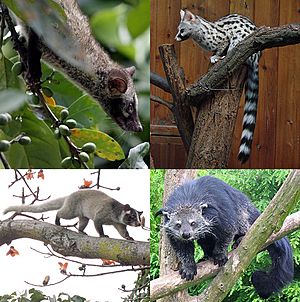Viverridae facts for kids
Viverrids are a family of small to medium-sized mammals. They are part of a group called Feliformia, which means "cat-like carnivores."
There are 15 different groups (called genera) and 33 species of viverrids. A scientist named John Edward Gray officially named this family in 1821.
You can find viverrids across Africa, the Oriental region (parts of Asia), and even in southern Europe. They also live in places like Madagascar and Sulawesi, showing they spread across the tropics of the Old World and even beyond a special boundary called Wallace's Line.
Most viverrids live in tropical rainforests. But some also make their homes in woodlands, savannas, and mountains.
Quick facts for kids ViverridaeTemporal range: Eocene to Recent
|
|
|---|---|
 |
|
| Viverrids, including (top left to bottom right), species of Paradoxurus, Genetta, Paguma and Arctictis | |
| Scientific classification | |
| Kingdom: | |
| Phylum: | |
| Class: | |
| Order: | |
| Suborder: | |
| Family: |
Viverridae
Gray, 1821
|
Contents
Types of Viverrids
Here are some examples of viverrid species:
What is a Civet Cat?
Many viverrids are known as civet cats. This includes groups like Vivera, Civettictis, and Viverricula. The name "civet cat" comes from their strong, noticeable smell. Sometimes, other cats that happen to be smelly are also called civet cats.
Viverrids from the group Genetta are called 'genets'. Another group, Poiana, are known as 'linsangs'. The genet species Genetta genetta is the only viverrid that lives in Europe. It's the one with the striped tail shown in the picture at the top right of the main image.
Viverrid Characteristics
Viverrids are considered some of the most basic or "primitive" cat-like animals. They are less specialized than the true cat family, Felidae. Their skeletons are very similar to fossils that are up to 50 million years old, from a time called the Eocene period.
You can tell viverrids apart from true cats by a few things. Their back feet have five toes. They usually have a longer snout and shorter legs. Their skulls are also different, as are their teeth. Many species have tails with stripes.
Even though viverrids belong to the order Carnivora (meat-eaters), most of them are omnivores. This means they eat both plants and animals. Some species, like the ones called "palm civets," are entirely herbivorous, meaning they only eat plants.
Civets and SARS
On January 13, 2004, the American Centers for Disease Control and Prevention (CDC) stopped the import of civets into the United States. This happened because the Severe Acute Respiratory Syndrome (SARS) virus was found in civets from China.
Images for kids
-
Binturong (Arctictis binturong) skeleton at the Museum of Osteology
See also
 In Spanish: Vivérridos para niños
In Spanish: Vivérridos para niños


